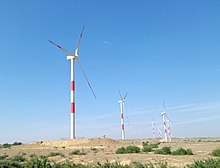Thatta
Thatta's Makli Necropolis, a UNESCO World Heritage Site, is site of one of the world's largest cemeteries and has numerous monumental tombs built between the 14th and 18th centuries designed in a syncretic funerary style characteristic of lower Sindh.
Muhammad bin Qasim captured the region in 711 CE after the defeating the local Raja in a battle north of Thatta.
Following Mahmud of Ghazna's invasion of Sindh in the early 11th century, the Ghaznavids installed Abdul Razzaq as Governor of Thatta in 1026.
In 1351, the Samma Dynasty, of Rajput descent from Sehwan, seized the city and made it their capital as well.
[9] In 1520, the Samma ruler Jam Feroz was defeated by Shah Beg of the Arghun-Tarkhun dynasty, which in turn had been displaced from Afghanistan by the expanding Timurid Empire in Central Asia.
[13] Nevertheless, some Portuguese presence was early in the 16th century with the conquest of Hormuz by Afonso de Albuquerque in 1507, which started the relationship with Sindi.
[13] Shah Jahan, while still a prince, sought refuge in the city from his father Emperor Jahangir.
[13] Between 1652 and 1660, the Dutch East India Company had a small trading post (comptoir or factory) in Thatta.
[18] Thatta was also home to a thriving silk weaving industry, as well as leather products that were exported throughout South Asia.
[18] Thatta'a revival was short lived as the Indus River silted in the second half of the 1600s, shifting its course further east and leading to the abandonment of the city as a seaport.
[20] In 1739, however, following the Battle of Karnal, the Mughal province of Sindh was fully ceded to Nadir Shah of the Persian Empire, after which Thatta fell into neglect, as the Indus river also began to silt.
The city then came under the rule of the Talpur dynasty, who divided the Sind into three units Khairpur, Haiderabad, Mirpurkhas and seized Thatta from the Kalhoras.
[11] After the independence of Pakistan most of the city's Hindu population, though like much of Sindh, migrated to India, Thatta did not experience the widespread rioting that occurred in Punjab and Bengal.
[22] Thatta's geology is characterized by volcanic and sedimentary rocks that are similar to those in the Indus plain, and Thar Desert.
[26] Last 10 years monsoon rains in Thatta were recorded as: An association football club, Jeay Laal, was established in 2020.


